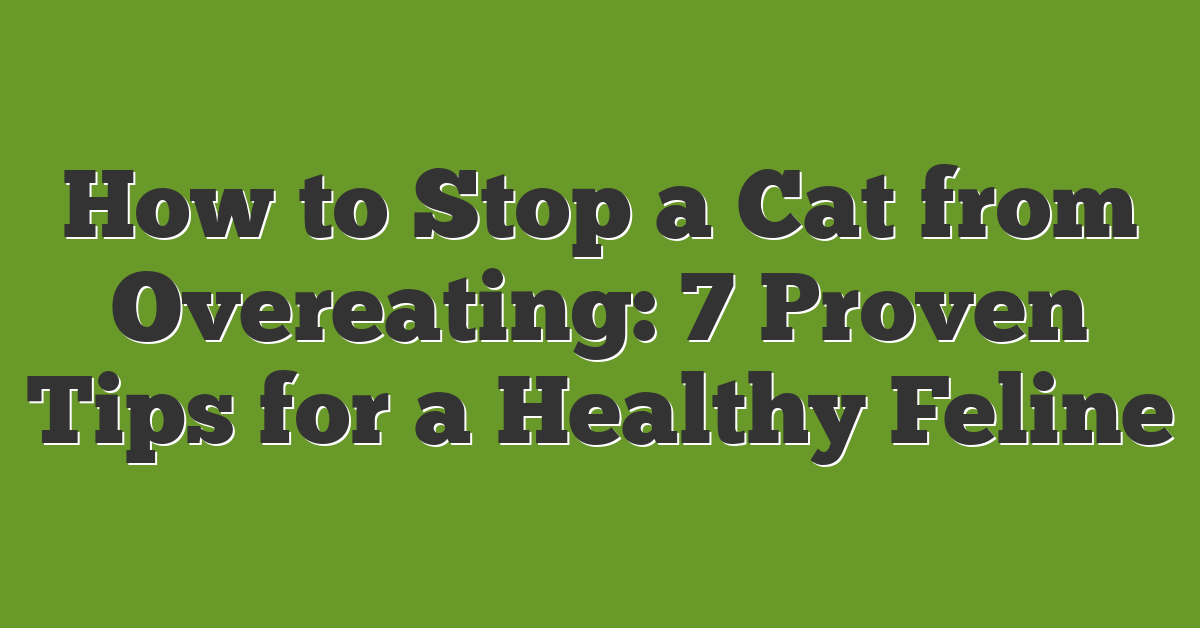Cats are such wonderful companions, but when they start overeating, it can become a real concern. I’ve been there, watching my furry friend gobble down his meals and wondering how to help him maintain a healthy weight. It’s not just about the extra pounds; overeating can lead to serious health issues down the line.

Finding the right balance between giving your cat treats and ensuring they get the proper nutrition can be tricky. I’ve discovered a few strategies that make managing your cat’s diet easier and stress-free. From understanding portion sizes to choosing the right food, these tips have made a big difference for both me and my kitty.
Let’s dive into some practical ways to help your cat curb their appetite and stay happy and healthy.
Understanding Cat Overeating
Cats overeat for various reasons. Identifying the cause helps manage their diet effectively.
Signs and Symptoms
Overeating leads to noticeable changes. You might see your cat’s weight increase quickly. They may beg for food more often or display constant hunger. Other signs include reduced activity, difficulty moving, and changes in behavior, like increased aggression or hiding during meal times.
Health Risks
Excessive eating poses several health dangers. Obesity is a primary concern, raising the risk of diabetes. Joint problems like arthritis become more likely as your cat gains weight. Additionally, heart disease can develop, and overall lifespan may decrease. Maintaining a balanced diet helps prevent these health issues.
Identifying the Causes
Understanding why your cat overeats helps address the issue effectively. I identify various factors that contribute to excessive eating.
Behavioral Factors
Hunger drives overeating in cats. I notice that some cats eat out of boredom, leading to weight gain. Stress also plays a role; anxious cats may seek comfort in food. Additionally, learned behaviors influence eating habits, such as begging for treats frequently.
Environmental Factors
Home environment impacts a cat’s eating patterns. I observe that easy access to food bowls encourages continuous eating. Lack of mental stimulation results in overeating as a source of entertainment. Moreover, inconsistent feeding schedules confuse cats, making it harder to manage their intake.
Strategies to Control Feeding
Managing your cat’s eating habits keeps them healthy and happy. I use several strategies to ensure my cat doesn’t overeat.
Portion Control
I measure my cat’s food daily to maintain the right amount. Scheduled feeding times create a routine, reducing constant hunger. I divide the daily food into two or three meals, preventing overeating. Using puzzle feeders makes mealtime engaging and slows down eating.
Choosing the Right Food
I select high-fiber cat food to promote fullness without extra calories. Low-calorie options help manage my cat’s weight effectively. Protein-rich foods support muscle maintenance and overall health. Consulting my vet ensures I choose the best diet for my cat’s specific needs.
Creating a Feeding Schedule
Setting up a feeding schedule keeps your cat’s eating habits in check. It establishes routine and prevents overeating.
Consistent Meal Times
I set regular feeding times each day. Feeding at the same times helps my cat know when to expect food. For example, I feed my cat at 7 AM and 6 PM daily. Consistency reduces anxiety and stops begging between meals.
Using Feeders and Puzzles
I use feeders and puzzle toys to make mealtime engaging. Puzzle feeders slow down my cat’s eating and provide mental stimulation. Options include treat-dispensing toys and slow-feed bowls. These tools help control portions and keep my cat active.
Monitoring Your Cat’s Progress
Keeping an eye on your cat’s health is essential. It ensures your furry friend stays happy and fit.
Tracking Weight
I weigh my cat every two weeks using a digital scale. Recording each weight helps me see trends over time. I keep a chart to track progress and spot any sudden changes quickly. Regular weight checks make sure the diet is effective and catch problems early.
Adjusting the Plan
If my cat’s weight isn’t changing as expected, I modify the feeding plan. I might reduce portion sizes or switch to a different food. Sometimes, I add more playtime to help burn calories. I also consult my vet to make informed decisions. Adjusting the plan keeps my cat on the path to a healthy weight.
Conclusion
Managing your cat’s eating habits really changes their life for the better. It might take some patience and consistency but the results are worth it. Watching your furry friend stay healthy and happy brings so much joy. Keep experimenting with what works best and enjoy the bond you share.
















